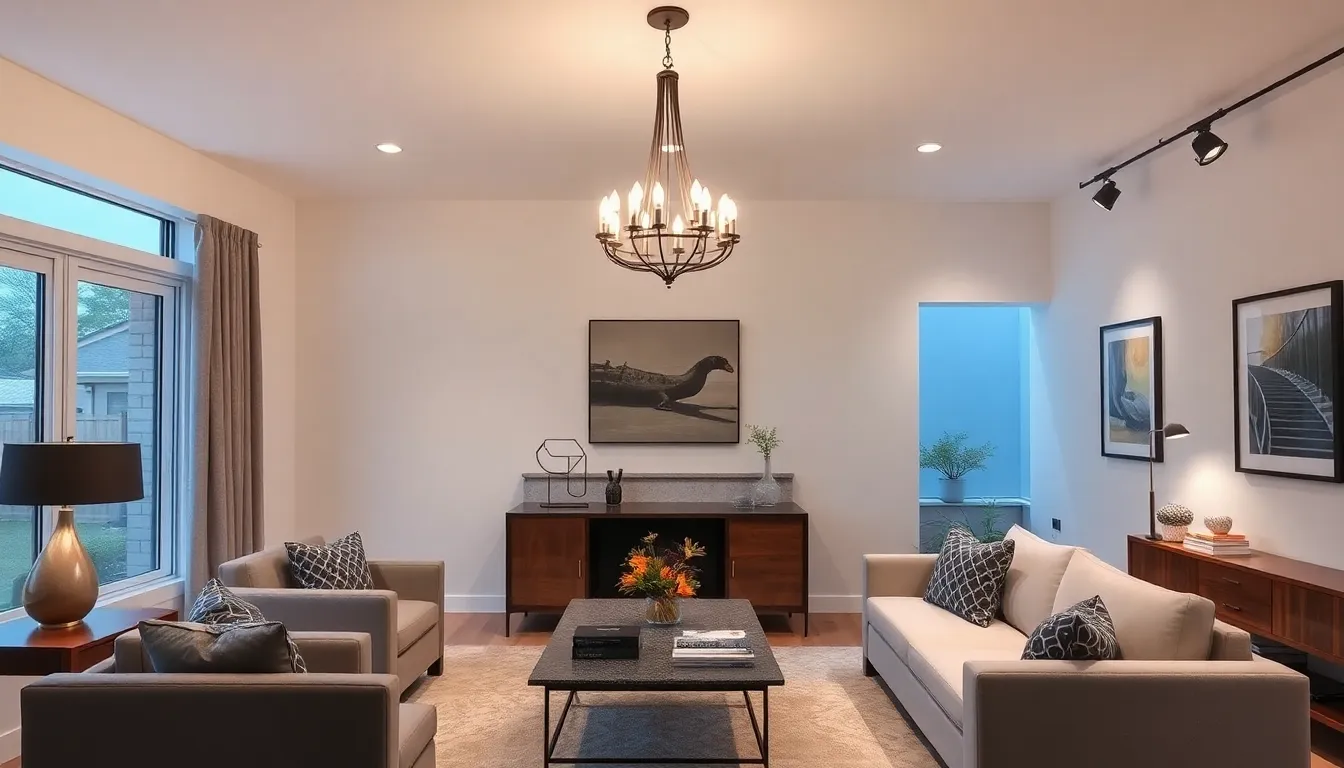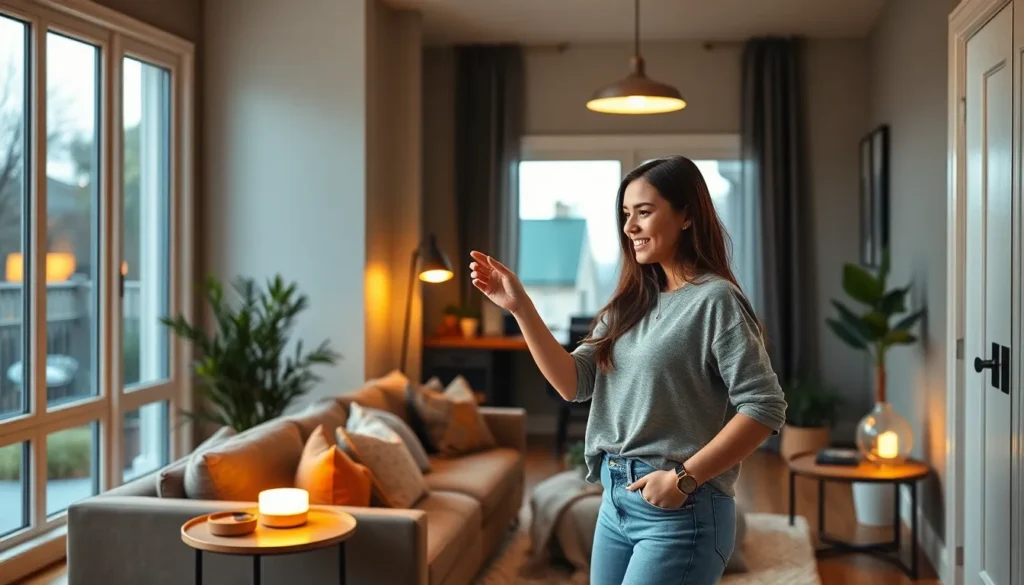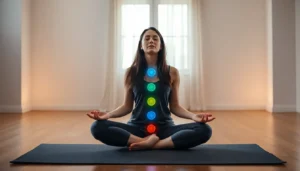Table of Contents
ToggleHome lighting isn’t just about flipping a switch; it’s the secret sauce that transforms a dull space into a cozy haven or an energizing workspace. Imagine walking into a room that feels like a warm hug or a vibrant burst of inspiration. With the right lighting, every corner of a home can radiate personality and charm, making it not just livable but lovable.
Overview Of Home Lighting
Home lighting serves various functions that contribute to comfort and functionality. Several types of lighting exist, each tailored for specific needs and aesthetic preferences. Ambient lighting creates a general illumination, ensuring spaces feel welcoming and vibrant. Task lighting focuses on specific areas, enhancing visibility for activities such as reading or cooking.
Accent lighting highlights architectural features or decor, adding visual interest. The combination of these lighting types offers flexibility in mood and atmosphere. Lighting design considers the layout of a room, maximizing its potential with strategic placements.
Energy efficiency plays a crucial role in modern home lighting, encouraging the use of LED bulbs that consume less power while providing ample brightness. Automation technologies, such as smart bulbs and dimmers, add convenience and adaptability to lighting systems. These innovations allow individuals to adjust the ambiance with ease, influencing not only aesthetics but also energy consumption.
Color temperature significantly affects mood. Warmer tones promote coziness, while cooler tones create a refreshing, energizing feel. Homeowners can select lighting that complements their preferences and the functions of different rooms.
Lastly, layer lighting enhances the sophistication of a space by combining different light sources. Proper planning and consideration of these elements facilitate a well-lit environment that aligns with a homeowner’s lifestyle and personal style.
Types Of Home Lighting

Home lighting encompasses various types designed to enhance the functionality and aesthetic appeal of a space. Understanding different types allows homeowners to create appropriate atmospheres tailored to specific needs.
Ambient Lighting
Ambient lighting provides the primary illumination in a room. This type of lighting generally fills the space with a soft glow, allowing for general visibility. Ceiling-mounted fixtures like chandeliers and recessed lights serve as common examples. Indirect light enhances comfort, creating a welcoming environment. Dimmers can adjust brightness levels, offering versatility according to the mood or activity at hand.
Task Lighting
Task lighting focuses on specific areas, providing bright light for activities. This lighting type is essential for workspaces, kitchens, and reading nooks. Desk lamps, under-cabinet lights, and wall-mounted fixtures often fill this role. It’s important to ensure proper placement to reduce eye strain, maximizing usability. Ideally, task lighting complements ambient lighting to create a well-rounded lighting scheme.
Accent Lighting
Accent lighting draws attention to particular features or areas within a room. This type enhances architectural elements and artwork, adding depth and interest. Spotlights and track lights often provide the necessary focus. By using accent lighting strategically, one can highlight favorite décor items or create a gallery-like atmosphere. This interplay of light enhances the overall aesthetic, contributing to a well-designed space.
Choosing The Right Home Lighting
Selecting appropriate home lighting involves understanding one’s space and identifying suitable light bulb options. The right choices can significantly enhance both functionality and aesthetics.
Consider Your Space
When choosing lighting, consider room dimensions. Each area requires different lighting levels; larger rooms benefit from multiple light sources. Light placement influences mood, making open spaces feel inviting while smaller areas gain warmth with softer lights. Think about activities conducted in each space. For example, kitchens require bright task lighting for cooking, whereas bedrooms may benefit from softer ambient light for relaxation. Incorporate the room’s purpose, maximizing its potential with thoughtful lighting decisions.
Light Bulb Options
Various light bulb types impact not just efficiency but also ambiance. LED bulbs, for instance, offer longevity and significant energy savings, consuming up to 80% less energy than traditional incandescent bulbs. Incandescent bulbs provide warm light but burn out quickly and use more electricity. Fluorescent lights deliver bright lighting with low heat emission, perfect for workspaces. Additionally, smart bulbs allow customization, including adjustable brightness and color temperature, aligning perfectly with the user’s lifestyle. Matching bulbs to fixtures creates cohesive design aesthetics throughout the home.
Benefits Of Proper Home Lighting
Effective home lighting enhances mood and comfort. Strategic lighting choices improve functionality within spaces. Proper illumination can increase productivity in work areas and relaxation in living rooms. Good lighting design contributes to safety, reducing accidents and improving visibility in homes.
Energy efficiency is a significant benefit of modern lighting technologies. Utilizing LED bulbs leads to lower energy consumption and reduced electricity costs. Smart lighting systems allow for automation, providing flexibility in adjusting brightness and color temperature based on activities and preferences.
Layered lighting enhances the overall aesthetic of a home. Combining ambient, task, and accent lighting creates depth and visual interest in each room. Accent lights showcase artwork or architectural features, adding character to the decor. A well-lit environment can even make spaces appear larger and more inviting.
Color temperature plays a crucial role in setting the right atmosphere. Warmer tones promote relaxation, while cooler tones can invigorate and energize. Adjusting lighting throughout the day supports the body’s natural rhythm and improves well-being.
Selecting appropriate lighting fixtures further emphasizes the unique style of a home. Statement pieces such as chandeliers or stylish lamps provide both function and visual appeal. Matching fixtures to the overall decor ensures coherence, reinforcing the home’s personality and charm.
Lastly, improving overall home lighting proves beneficial for emotional health. Well-lit spaces can enhance focus and motivation, contributing to better productivity and a more positive mindset. Choosing the right lighting ultimately transforms any house into a comfortable and inspiring home.
Home Lighting Trends
Home lighting trends showcase innovative designs and efficient technologies. Minimalism continues to dominate, with sleek fixtures that blend seamlessly into any decor. Statement lighting emerges as a focal point, drawing attention and adding character to spaces.
Eco-friendly options gain popularity, featuring energy-efficient LED bulbs and sustainable materials. Warm white light creates inviting atmospheres, making spaces feel cozy and comfortable. Layered lighting remains essential, allowing flexibility to adjust ambiance throughout the day. Combining various sources enhances functionality while achieving visual appeal.
Smart lighting systems revolutionize home illumination. These devices allow users to control brightness and color temperature remotely, catering to individual needs. Voice-controlled options streamline convenience, integrating effortlessly into daily routines.
Trendy fixtures highlight geometric shapes and bold colors, contributing to visually striking interiors. Vintage-inspired designs retain their charm, bringing nostalgia back into modern homes. Adjustable task lighting becomes crucial in workspaces, ensuring that specific areas meet functional requirements.
The use of natural light also influences current trends. Large windows and skylights maximize daylight, reducing reliance on artificial sources. Designers pay close attention to how sunlight interacts with space throughout the day.
Innovative applications of color temperature foster distinct moods. Cooler tones enhance focus and energy, ideal for kitchens and home offices. Warmer tones promote relaxation in living areas, reinforcing comfort and tranquility.
Incorporating personalized styles into lighting choices reflects homeowner preferences. Unique fixtures and colors provide distinct character while enhancing overall design aesthetics. Adopting these trends ensures that lighting complements not only functionality but also personal expression in every space.
Home lighting plays a crucial role in shaping the atmosphere and functionality of a living space. By understanding the different types of lighting and their specific purposes, homeowners can create environments that enhance comfort and reflect personal style.
Incorporating energy-efficient solutions and smart technologies not only contributes to sustainability but also adds convenience to everyday life. As trends continue to evolve, the focus remains on blending aesthetics with practicality.
Ultimately, the right lighting transforms a house into a home, promoting emotional well-being and enhancing the overall living experience. Embracing thoughtful lighting choices can lead to a more inviting and inspiring atmosphere for everyone.







